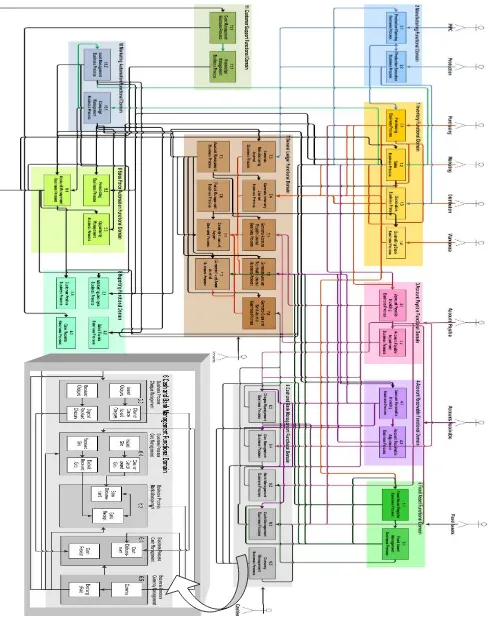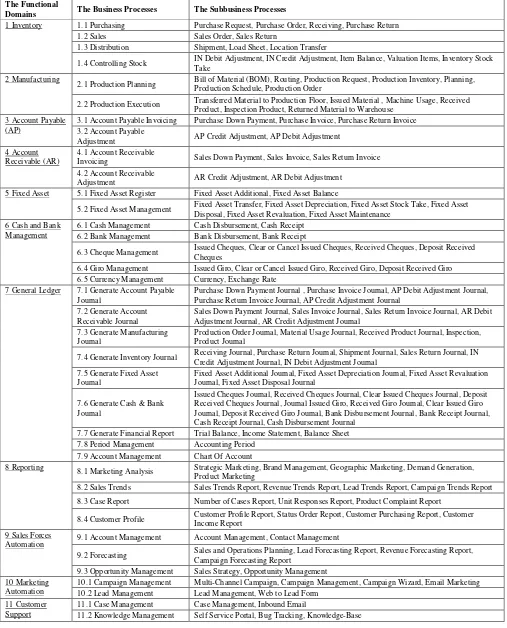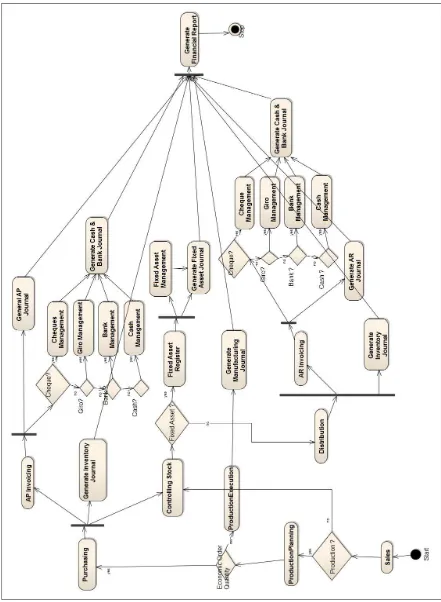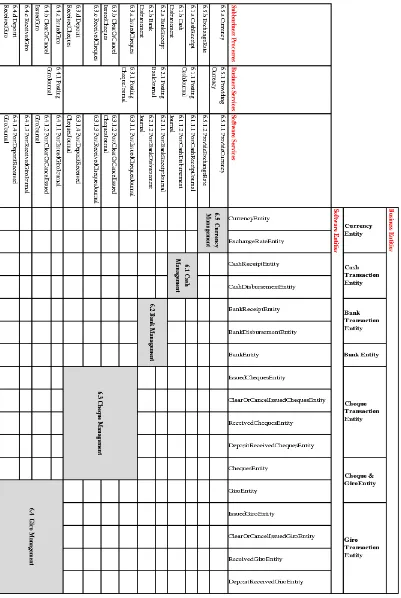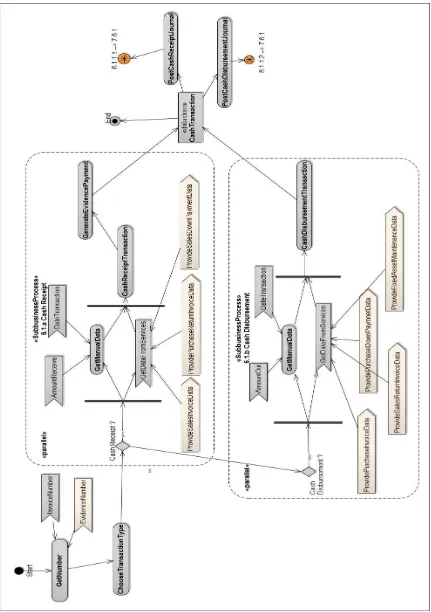A Service Portfolio for an Enterprise Resource Planning
Riyanarto Sarno and Anisah Herdiyanti
,
Faculty of Information Technology, Institut Teknologi Sepuluh Nopember, Surabaya, 60111 Indonesia
Summary
The rapid changing of business environments requires state of the art software engineering methods, which support integration, reusability, loose coupling, extensibility and interoperability. Since Service-Oriented Architecture (SOA) provides these requirements, this paper proposes the service portfolio of an Enterprise Resource Planning (ERP), which accommodates the Information Technology (IT)-related business goal, i.e. creates agility in responding to changing business requirements, and also facilitates the functionalities in a commonly standard ERP. The service portfolio provides three levels of views, which are the conceptual view, the logical view, and the physical view. The conceptual view provides the services which support governance requirements, while the logical view serves the architecture components of the services; whereas the physical view identifies the programming implementation of the services. In order to design the conceptual view of an ERP, we employ Control Objectives for Information and Related Technology (COBIT) to identify the IT-related business goal and align to the IT goals and the related IT processes. Furthermore, The Open Group Architectural Framework (TOGAF) is used as a framework to specify the business architecture. Then, the logical view is designed by referring to the application and data architectures of Enterprise Architecture (EA). The EA concepts are used together with SOA concepts to further elaborate the design. Moreover, the physical view is constructed, which contains of the four layers of technical SOA implementation for the ERP. It was shown that the service portfolio accommodated the business goals and also facilitated the functionalities in a commonly standard ERP. Further, the service portfolio was designed based on SOA concept to support reusability, loose coupling, extensibility, interoperability, and integration capability.
Key words:
COBIT, ERP, SOA, TOGAF, service portfolio
1.
Introduction
In the last decades, technology development has been growing significantly together with the rapid changing of business needs. The structure of business organizations were vertical and isolated business divisions until 1980. The structures evolved to the horizontal business-process-focused structures from 1980 to 1990. Since 1990 the new
ecosystem business paradigm has been evolving. In this regard, business services need to be componentized and distributed, and focused on the extended supply chain,enabling customer and partner access to business services [1].
A service represents specific business function while a system contains of organized services to accomplish a specific objective [2]. The communication between services should be independent in order to face the rapid business changes. Thus, a service portfolio is required for service consolidation through the communication. It holds information such as, service definition, access and usage policies and nonfunctional requirement for a service. Furthermore, a service portfolio is impacted by the conceptualization of services and governance needs, while the logical view provides the architecture components for the services conceptualized; whereas the physical view identifies the physical implementation components of the services [3].
A service provides a single discrete business function, such as calculating total sales; or a set of related business functions, such as analyzing sales history. A service that perform a single function is said to be fine grained, while services which perform a related set of business functions are called to be coarse grained [4]. The services can also be aggregated to satisfy more complex business requirements. In this context, a Service-Oriented Architecture (SOA) can be seen as an approach to connect services. These services can communicate with each other to share business functions in a widespread and flexible way.
A well constructed SOA can support business goals with flexible infrastructures and processing environment, which are achieved by providing independent and loosely coupled services in the automated business processes. The services should be robust and secure in order to optimally empower the business.
SOA can be considered as a good enterprise architecture, which is described in Enterprise Architecture (EA). Hence, SOA is a subset of EA because it shows how to develop good EA through a service orientation. EA represents the structure of IT resources (information, application, infrastructure, people) in an organization into four architectures; which are the business architecture, the application architecture, the information achitecture and the technology architecture.
For successfully implementation of EA, a framework to develop IT resource within EA is needed. There are many frameworks can be used as a guidance, such as : The Open Group Architectural Framework (TOGAF) and Zachman Framework for Enterprise Architectures, which define a process and a taxonomy, respectively [6]. Furthermore, TOGAF has been mapped to Control Objectives for Information and Related Technology (COBIT) [7] to provide a framework for generic view of IT-related business goals, the IT goals and the related IT processes. It also explains about a concept of enterprise architecture for developing the IT resources managed by the IT processes. wants to achieve the objectives. The business goals should be aligned with the IT goals [9] to ensure that IT successfully delivers services in supporting enterprise strategy. We use COBIT [7] to align the business goals and the IT goals. Hence, the service portfolio can align the business goals with the commonly typical standard of an ERP to further elaborate the design.
Moreover, the service portfolio is designed by considering the functionalities in a standard ERP. The design also facilitates reverse engineering principle by preserving consistency of the design and its software engineering concepts of reusability, loose
coupling, extensibility, interoperability, and integration capability.
2.
Theoretical Consideration
2.1
Control Objectives for Information and Related
Technology
(C
OBIT)
COBIT is an IT Governance framework which can help enterprise to ensure the IT supports to businessgoals. The IT governance brings access control and policies into the way in which the IT resources are managed within an IT process. It is important to create a set of principles, laws and policies that are clear and easy to understand by people in the enterprise. Furthermore, the IT governance needs to be effectively communicated the enterprise’s expectation in business.
COBIT framework provides a reference process model and common language for IT activities. These activities are groupped into four domains; which are the Plan and Organise (PO), the Acquire and Implement (AI), the Deliver and Support (DS), and the Monitor and Evaluate (ME). Those domains contain of 34 IT processes. Each of the IT process consists of control objectives, maturity model and general measurement for monitoring the IT process performance [10,11]. The PO domain covers strategy and concerns with the identification of IT contribution to the achievement of business goals; whereas the AI domain is about developing and acquiring IT solutions. The DS domain concerns with the actual delivery of IT to achieve the business goals while the ME domain addresses performance management, including the regulatory compliance [7].
Furthermore, COBIT defines information criteria which provide a generic method of business requirement. These criteria are delivered by the IT processes that manage the IT resources. Hence, the business goals for IT should be aligned with the IT goals to ensure that IT successfully delivers services in supporting enterprise strategy. The relationship between business and IT goals helps demonstrating how the IT goals contribute to the delivery of business needs. Thus, this relationship is important for providing information of how IT fulfils the requirement of business needs[12].
presented by the IT Governance Institute [13].
2.2
Enterprise Architecture (EA)
An Enterprise Architecture (EA) is described as a set of standards and methodologies that describe architectural vision for an enterprise [6]. EA represents the fundamental description of an enterprise with its business process, software applications that provide the services, the technical infrastructure and strategy which contains principles and standards [14].
The advantages of EA are a support for IT management decision, a tool for communication, regulation and law compliance, and an improvement for organization’s performance and innovation. Moreover, EA can optimize cost savings regarding with IT investment.
EA consists of four architectures, which are the business architecture, the application architecture, the information achitecture and the technology architecture [15]. The business architecture defines the strategies in business, the key business processes, the governance and the organizational structure; while the application architecture provides the blueprint of applications or systems and the interactions with the main business processes in organization. The information architecture describes the organizational and the data management resources that represent the logical and the physical data assets; whereas the technology architecture represents the software infrastructures to support the deployment of core applications.
This research uses TOGAF framework due to the existing relationship with COBIT framework through the IT processes approach [13]. TOGAF provides the detailed methods and a set of supporting tools for developing an enterprise architecture [16]. Josey [17] defines TOGAF as a de facto global standard for assisting in the acceptance, the production, the use, and the maintenance of architectures.
TOGAF Architecture Development Method (ADM), which is a part of TOGAF framework, provides a method for developing enterprise architecture [18]. TOGAF ADM represents four architectures; they are business architecture, data architecture, application architecture and technology architecture. The four architectures in TOGAF are the same as architectures defined in EA, except the term of the information architecture in EA is defined as data Service Provider to deliver a particular business process; while the services provided are based on pre-defined service contracts that guarantee a minimum service level. The Service Registry holds the descriptions and contracts associated with the services available for consumption.
The communication between the Service Consumer, the Service Registry and the Service Provider of services can address the business changes. In order to face the changing requirements of business needs, the services are expected to be as agile as possible. The efficiencies in the design, the implementation and the operation of the SOA-based systems support the business organization to response the changing of business environment.
Figure 1 represents the key concepts of the SOA. It shows that the Service Consumer requests services to the Service Registry and binds to the services over a transport, while the Service Provider addresses this request and publishes the services and its contract to the Service Registry. The Service Consumer can discover and access the service through the Service Registry [1].
The consolidation of the services is defined in the service portfolio. This portofolio translates business needs into IT supports by designing capable business services. A service portofolio is provided in three levels of views : the conceptual view, the logical view and the physical view. The conceptual view supports service concept and the need of governance, while the logical view serves the achitecture components for the service concept; whereas the physical view identifies the programming implementation of the services [20].
Fig. 1 The key concepts of the SOA.
2.4
Enterprise Resource Planning (ERP)
become tools that enable organizations to standardize business processes [21]. The basic purpose of standardization is to achieve the most efficient use of resources.
An ERP is currently a great success with companies and its implementation has entailed remodelling management information systems (MIS) and reconsidering management procedures within the organization. Henceforth, an ERP is now tools that enable companies from multinationals to standardize their management processes. It offers rich and proven functionalities, based on best practices. Mourlon and Neyer [22] emphasize the standarization generated by an ERP, since it enables everyone to work in the individual language but can be understood each other.
The functionalities of a typical ERP system are Product Forecasting, Production Scheduling, Materials Management, Inventory Management, Purchasing And Receiving, Sales Operations, Distribution and Logistics, Accounts Payable, Accounts Receivable, Fixed Asset, General Ledger, Product Marketing, Strategic Marketing, and Technical Support. Other functionalities will also be implemented are Cash and Bank Management, and Human Resource Management [8].
Furthermore, an ERP is commonly used as a basis for the best practices and best management processes [8], which offers methods that are recognized as the most advanced in the business world or in a given industry. The analysis of best practices enables an organization to define a set of management rules which constitute a standard for a given sector. Then the standard of the business processes is not only on the scale of an organization, but also on the entire industries.
3.
Methodology Consideration
The service consolidation is facilitated in the service portfolio by considering the functionalities in a typical standard of an ERP. The service portfolio contains of three levels of views : the conceptual view, the logical view and the physical view. The conceptual view of ERP is designed by employing COBIT framework to harmonize the representation of the conceptual view, which describes the interaction between the actors and the functional diagram, and the hirearchy of services. The conceptual view contains the functional domains, the business processes,
the business services, the software services, and the software components or the software entities. Further, the conceptual view also contains the business process activity diagram (BPAD) and the subbusiness process activity diagram (SBPAD), which describes sequence of activities. In BPAD and SBPAD, an activity represents a business process and a subbusiness process, respectively.
The logical view is designed based on Enterprise Architecture (EA) together with Service-Oriented Architecture (SOA) methods for effective development of the services. The logical view describes the decomposition of the business services into the software services, and the business entities into the software entities. Then, each of the business process is elaborated by sequence of activities, which represent the business services, the software services, and the webmethods. The activities are grouped into the related-subbusiness process.
The physical view consists of the presentation layer, the application service layer, the domain model layer, and the data access layer. The presentation layer represents Graphical User Interface (GUI), whereas the application service layer consists of the software services and the webmethods. A webmethod represents an operation or a set of operations for web services. The domain model layer consists of classes, the software or class activity diagrams, and the sequence diagrams. Each class contains of a software entity and the methods. A method represents an operation or a set of operations for the software entities. A software or class activity diagram is derived from the corresponding SBPAD, and a sequence diagram models the flow of logic of a service; therefore there is correlation between a sequence diagram and a method. Further, the data access layer includes the operations of Create, Read, Update and Delete (CRUD) and the Object Relational Mapping (ORM). Based on the four layers of the physical view, then the Business Process Execution Language (BPEL) of the software services is developed.
4.
The Proposed Service Portfolio of an ERP
The COBIT framework provides the linkages among the business goals, the IT goals and the related IT processes, that can help demonstrate how IT contribute to the delivery of business needs. The IT goals for the business goals are responding to business requirements in alignment with the business strategy, creating IT agility
and delivering projects on time and on budget, meeting quality standards. Then, the IT-processes are mapped into TOGAF for developing enterprise architecture in order to achieve the IT goals through the IT processes. The IT processes addressed by TOGAF are define the information architecture (PO2), determine technological direction
(PO3), define IT processes, organization and relationship
(PO4), identify automated solutions (AI1), and define and manage service levels (DS1).
The IT processes PO2, PO3, PO4 and AI1 relate with the development of Enterprise Architecture (EA). The IT process define the information architecture (PO2) defines the information architecture in EA; while the IT process determine technological direction (PO3) serves technology architecture in EA. Furthermore the IT process define IT processes, organization and relationship (PO4) includes the designing of business architecture in EA; whereas the IT process identify automated solutions (AI1) focuses on identifying technically feasible and cost effective solutions for a new application or function, which is then structured into a blueprint of application as a part of application architecture in EA. Hence, the development of service portfolio can refer to TOGAF which is linked to COBIT as a framework. Moreover, the service portfolio also considers the functionalities of a standard ERP, that usually are used in an enterprise for business process improvement.
In the service portfolio, the functionalities are grouped into the functional domains, which then are decomposed into the business processes and the corresponding subbusiness processes. The functional domains, the business processes and the related actors of an ERP system can be seen in Figure 2. It shows the consolidation of services to satisfy the business needs of the actors. The actor represents the person who is responsible for a business process or a functional domain. Moreover, the Responsible, Accountable, Supportive, Consulted and Inform (RASCI) actors can be assigned to show the involvement and the functional roles of the actors in activities within the business processes.
Figure 2 shows eleven functional domains of an ERP, which are Inventory, Manufacturing, Account Payable, Account Receivable, Fixed Assets, Cash and Bank Management, General Ledger, Reporting, Sales Force Automation, Marketing Automation and Customer Support, which are assigned with the identification numbers starting
from one to eleven, respectively. Each functional domain contains one or more business processes and the related subbusiness processes. The relations among business processes represent the communication of the subbusiness processes. Table 1 describes the eleven functional domains of the ERP and the corresponding business processes and the subbusiness processes.
In this paper, we use Cash and Bank Management functional domain as an example to describe the conceptual view, the logical view and the physical view of the service portfolio. Figure 3 shows the decomposition of Cash and Bank Management functional domain into the software services, and the corresponding software components or software entities.
The communication among the business processes is needed to help understanding the sequence activities between the functional domains. The business process activity diagram (BPAD) describes the sequence of activities within an ERP system; in which an activity represents a business process. Figure 4 shows the BPAD of an ERP system, which relates to sales and purchasing business activities. Further, the activities between the subbusiness processes are designed to give detailed information about how a subbusiness process communicates to others. The subbusiness process activity diagram (SBPAD) describes the sequence of activities between the subbusiness processes; in which an activity represents a subbusiness process.
Hence, the conceptual view of an ERP is described from Figure 2 to Figure 4. The conceptual view describes the division of an ERP system into the functional domains, the business processes and the subbusiness processes. It also shows the functional connectivities of the business processes and the subbusiness processes.
Table 1: The functional domains and the corresponding business processes in the ERP system.
The Functional
Domains The Business Processes The Subbusiness Processes
1 Inventory 1.1 Purchasing Purchase Request, Purchase Order, Receiving, Purchase Return
1.2 Sales Sales Order, Sales Return
1.3 Distribution Shipment, Load Sheet, Location Transfer
1.4 Controlling Stock IN Debit Adjustment, IN Credit Adjustment, Item Balance, Valuation Items, Inventory Stock Take
2 Manufacturing
2.1 Production Planning Bill of Material (BOM), Routing, Production Request, Production Inventory, Planning, Production Schedule, Production Order
2.2 Production Execution Transferred Material to Production Floor, Issued Material , Machine Usage, Received Product, Inspection Product, Returned Material to Warehouse
3 Account Payable (AP)
3.1 Account Payable Invoicing Purchase Down Payment, Purchase Invoice, Purchase Return Invoice 3.2 Account Payable
Adjustment AP Credit Adjustment, AP Debit Adjustment 4 Account
Receivable (AR)
4.1 Account Receivable
Invoicing Sales Down Payment, Sales Invoice, Sales Return Invoice 4.2 Account Receivable
Adjustment AR Credit Adjustment, AR Debit Adjustment 5 Fixed Asset 5.1 Fixed Asset Register Fixed Asset Additional, Fixed Asset Balance
5.2 Fixed Asset Management Fixed Asset Transfer, Fixed Asset Depreciation, Fixed Asset Stock Take, Fixed Asset Disposal, Fixed Asset Revaluation, Fixed Asset Maintenance
6 Cash and Bank Management
6.1 Cash Management Cash Disbursement, Cash Receipt 6.2 Bank Management Bank Disbursement, Bank Receipt
6.3 Cheque Management Issued Cheques, Clear or Cancel Issued Cheques, Received Cheques, Deposit Received Cheques
6.4 Giro Management Issued Giro, Clear or Cancel Issued Giro, Received Giro, Deposit Received Giro 6.5 Currency Management Currency, Exchange Rate
7 General Ledger 7.1 Generate Account Payable Journal
Purchase Down Payment Journal , Purchase Invoice Journal, AP Debit Adjustment Journal, Purchase Return Invoice Journal, AP Credit Adjustment Journal
7.2 Generate Account Receivable Journal
Sales Down Payment Journal, Sales Invoice Journal, Sales Return Invoice Journal, AR Debit Adjustment Journal, AR Credit Adjustment Journal
7.3 Generate Manufacturing Journal
Production Order Journal, Material Usage Journal, Received Product Journal, Inspection, Product Journal
7.4 Generate Inventory Journal Receiving Journal, Purchase Return Journal, Shipment Journal, Sales Return Journal, IN Credit Adjustment Journal, IN Debit Adjustment Journal
7.5 Generate Fixed Asset Journal
Fixed Asset Additional Journal, Fixed Asset Depreciation Journal, Fixed Asset Revaluation Journal, Fixed Asset Disposal Journal
7.6 Generate Cash & Bank Journal
Issued Cheques Journal, Received Cheques Journal, Clear Issued Cheques Journal, Deposit Received Cheques Journal, Journal Issued Giro, Received Giro Journal, Clear Issued Giro Journal, Deposit Received Giro Journal, Bank Disbursement Journal, Bank Receipt Journal, Cash Receipt Journal, Cash Disbursement Journal
7.7 Generate Financial Report Trial Balance, Income Statement, Balance Sheet 7.8 Period Management Accounting Period
7.9 Account Management Chart Of Account 8 Reporting
8.1 Marketing Analysis Strategic Marketing, Brand Management, Geographic Marketing, Demand Generation, Product Marketing
8.2 Sales Trends Sales Trends Report, Revenue Trends Report, Lead Trends Report, Campaign Trends Report 8.3 Case Report Number of Cases Report, Unit Responses Report, Product Complaint Report
8.4 Customer Profile Customer Profile Report, Status Order Report, Customer Purchasing Report, Customer Income Report
9 Sales Forces
Automation 9.1 Account Management Account Management, Contact Management
9.2 Forecasting Sales and Operations Planning, Lead Forecasting Report, Revenue Forecasting Report, Campaign Forecasting Report
9.3 Opportunity Management Sales Strategy, Opportunity Management 10 Marketing
Automation
10.1 Campaign Management Multi-Channel Campaign, Campaign Management, Campaign Wizard, Email Marketing 10.2 Lead Management Lead Management, Web to Lead Form
11 Customer Support
11.1 Case Management Case Management, Inbound Email
Furthermore in Figure 5, the gray areas at the intersection between the business services and the business entities represent the business processes in the functional domain. Then, the activities inside those business processes are drawn. Figure 6 shows the business service activity diagram, which describes the activities for delivering the business service in the cash management business process. The activities can be done manually or automatically within the application. Furthermore, an activity can represent a process of sending or receiving service, or storing data in the data store. The stored data can be used later when they are needed by other services.
The physical view of the service portfolio consists of the presentation layer, the application service layer, the domain model layer, and the data access layer. The contents of the layers are taken from those of the logical view. The presentation layer represents Graphical User Interface (GUI), which are developed by referring the ERP functionalities. The application service layer contains webmethods and software services which are taken from the logical view; whereas the domain model layer contains classes, the class activity diagrams and the sequence diagrams, which are correlated to the corresponding methods. The data access layer contains the operations of Create, Read, Update and Delete (CRUD), and the Object Relational Mapping (ORM) for the software entities. The software services are developed using Business Process Execution Language (BPEL), which are derived from the software or class activity diagrams.
5.
Conclusions
We have proposed the service portfolio of an ERP which contains of the conceptual view, the logical view and the physical view. The conceptual view consists of the functional domain diagram, the mapping of the functional domains, the business process activity diagrams, and the subbusiness process activity diagrams. The functional domain diagram provides useful information for stakeholder to recognize the ERP functionalities, which are categorized into the functional domains, the business processes and corresponding subbusiness processes. Furthermore, the mapping of the functional domain shows the ERP functionalities which can be supported by the services.
The logical view contains business activities within the business processes, the matrix of the business services versus the business entities. The physical view is designed for the programming of the ERP system. It includes the presentation layer, the application service layer, the domain model layer, and the data access layer. The
software or class activity diagrams within the domain model layer can be translated into the Business Process Execution Language (BPEL). Hence, the design and implementation of the proposed service portfolio facilitates reverse engineering concept in order to preserve the consistency between the design and the coding.
Acknowledgements
We would like to thank for the design contribution from our colleague Rizky Januar Akbar, and students Riska Arinta and Safuwan, who are members of the Software Engineering Laboratory, Faculty of Information Technology, Institut Teknologi Sepuluh Nopember.
References
[1] Patterns : Service –Oriented Architecture and Web Services, IBM Corp., 2004.
[2] Architecting the Enterprise Ltd., Aligning ITIL V3 Service Design with TOGAF 9, USA, 2009.
[3] J. Banerjee and S. Aziz, “Enterprise Architecture (EA), Service Oriented Architecture (SOA), Solution Architecture
(SOLA)”, SETLabs Briefings, vol.5, no.2, pp. 69-80, 2007. [4] SOA Development Life Cycle Management, Methodologies
Corporation, (646) 290-5894.
[5] H. Meyer and G. Laures, SOA Governance using Tagging. Germany : University of Postdam.
[6] R. Sessions. (undated). Comparison of the Top Four Enterprise Architecture Methodologies. [Online]. 2010 January 01. Available : www.objectwatch.com
[7] IT Governance Institute, COBIT 4.1, USA, 2007.
[8] C. A. Ptak and E. Schragenheim, ERP : Tools, Techniques, and Applications for Integrating the Supply Chains, United States of America: CRC Press LLC, 2000.
[9] IT Governance Institute, Understanding How Business Goals Drive IT Goals, USA, 2008.
[10]R. Sarno, Audit System and Information Technology, Surabaya : ITS Press, 2009.
[11]R.S. Kaplan and D.P. Norton, The Balanced Scorecard: Translating Strategy into Action, Massachusetts : Harvard Business School Press, 1996.
[12]R. Sarno, Business Success Strategy utilizing Information Technology, Surabaya : ITS Press, 2009.
[13]IT Governance Institute, COBIT Mapping : Overview of International IT Guidance, 2nd Edition, , USA, 2006. [14]A. Campbell. (undated). EA Overview. [Online]. Viewed
2010 January 03. Available :
http://iea.wikidot.com/overview
[15]D. Minoli, Enterprise Architecture A to Z, US, 2008. [16]S. Morar, “One hour tutorial to TOGAF for Freshers”, The
Open Group, London, 2008.
[17]A. Josey, TOGAFTM Version 9 Enterprise Edition : An Introduction, San Fransisco : The Open Group, 2009. [18]A. Dico, “Delivering SOA with TOGAF”, presented at The
Open Group Conference, San Fransisco, 2008.
[20]S. Lowe, “EA and SOA: deploying your SOA resources”, presented at The Open Group EA London Event, London, 2006.
[21]T. Chtioui, “Does the strandardization of business processes improve management? The case of Enterprise Resource
Planning systems”, in Risk Management and Value : Valuation and Asset Pricing, World Scientific Studies in International Economics, vol. 3, M. Bellalah, Jean-Luc Prigent and Jean-Michel Sahut, Ed. Singapore : World Scientific Publishing Co. Pte. Ltd., 2008, pp. 601-614. [22]S. Mourlon and L.Neyer. Tout ce que nous avons voulu
savoir sur les ERP, Paris : Les Annales des Mines, 2002.
Riyanarto Sarno was born in Surabaya in
August 1959. The author’s educational
background is Ir. degree in Electrical Engineering from Bandung Institute of Technology, Indonesia 1983 and Drs. degree in Economics from Padjajaran University 1985. This author earned MSc. and PhD in Computer Science from University of Brunswick Canada in 1988 and 1992, respectively.
He was the Chairman of Institute of Technology Development for Community. He is currently the Head of Software Engineering Laboratory and the Dean of Information Technology Faculty, Sepuluh Nopember Institute of Technology. He wrote three books entitled Business Success Strategy utilizing Information Technology (Surabaya, Indonesia : ITS Press, 2009), Audit System and Information Technology (Surabaya, Indonesia : ITS Press, 2009), and Information Security Management System based on ISO 27001 (Surabaya, Indonesia : ITS Press, 2009). For international recognition, he had been appointed as an Adjunct Professor at the University of New Brunswick, Canada from 2004 to 2008. His research and teaching interests include Audit and IT Governance Frameworks, Software Engineering, Enterprise Service Oriented Architecture, and Information Security Management Systems.
Anisah Herdiyanti was born in Surabaya in January 1987. The
author’s educational background is
S.Kom degree in Information Systems from Sepuluh Nopember Institute of Technology, Indonesia, 2008. She is now pursuing further study in Engineering and Policy Analysis master program, Delft University of Technology, Netherlands.

